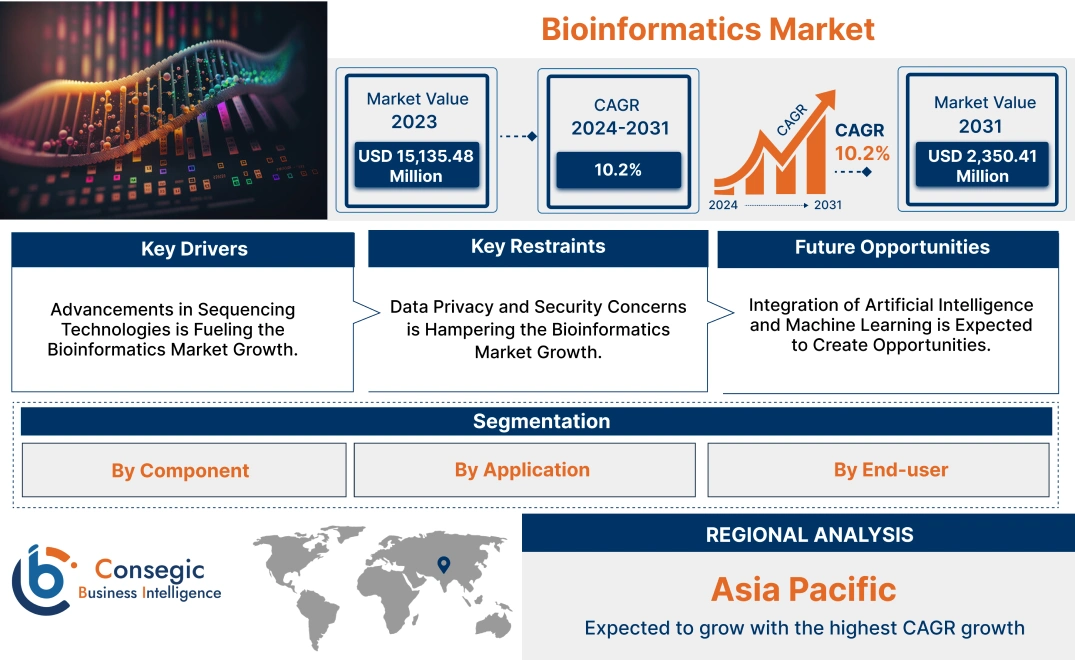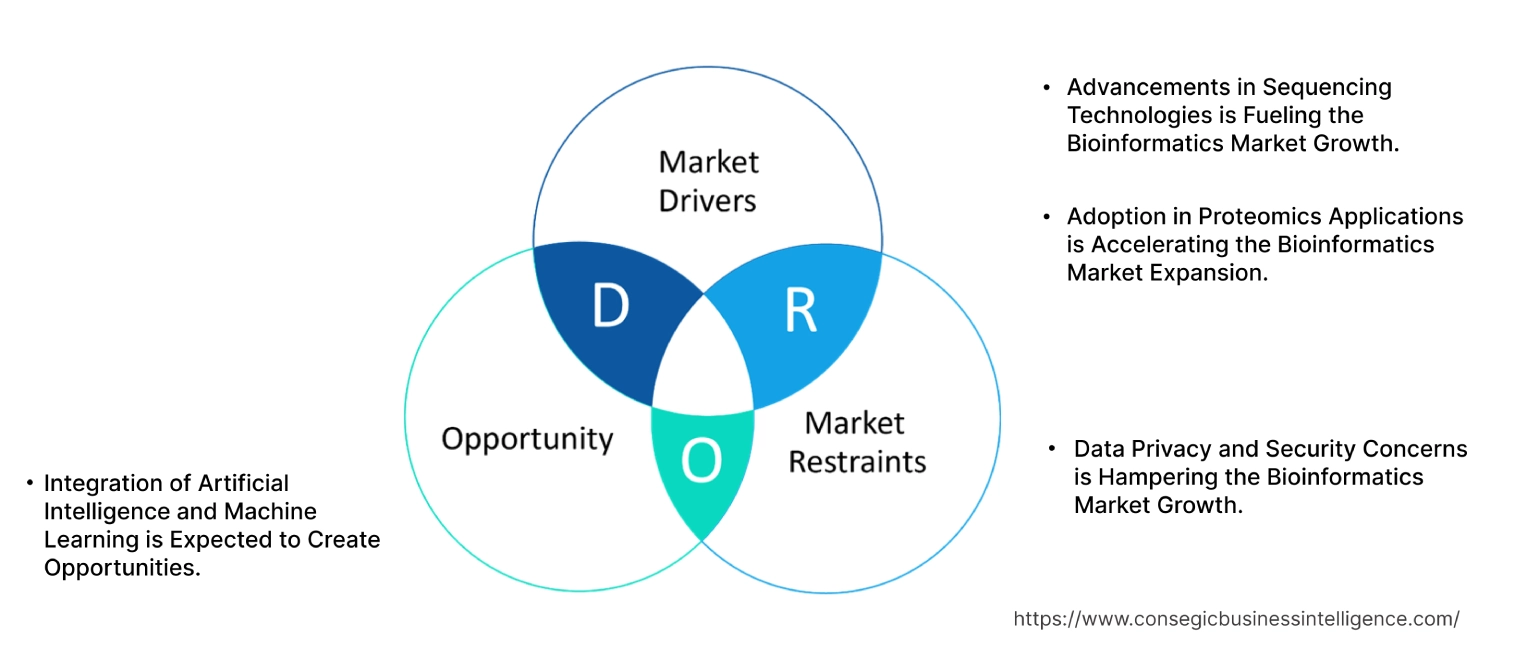Bioinformatics Market Size:
Bioinformatics Market size is growing with a CAGR of 10.2% during the forecast period (2024-2031), and the market is projected to be valued at USD 32,663.77 Million by 2031 from USD 15,135.48 Million in 2023.
Bioinformatics Market Scope & Overview:
Bioinformatics is an interdisciplinary field that integrates biology, computer science, mathematics, chemistry, and statistics for the analysis, exploration, and integration of biological data. It deals with the storage, retrieval, analysis, and interpretation of biological data using software and tools. The field encompasses several components including platforms, tools & software, and services. These components are designed for applications such as genomic sequence analysis, protein structure prediction, metabolic pathway analysis, target optimization, and lead optimization among others. Owing to the wide range of applications, bioinformatics serves a crucial role in genomics, proteomics, metabolomics, and pharmacology among others.
How is AI Impacting the Bioinformatics Market?
AI is profoundly impacting the bioinformatics market by accelerating and refining the analysis of vast biological datasets. Machine learning and deep learning algorithms are now essential for tasks like gene sequencing, protein structure prediction, and drug discovery, far surpassing traditional methods in speed and accuracy. AI helps identify complex patterns in genomics, proteomics, and metabolomics data, leading to the discovery of new biomarkers and disease pathways. This enables more precise predictive modeling for personalized medicine and accelerates the drug development pipeline. The integration of AI tools also automates routine data processing, freeing up bioinformaticians to focus on higher-level research and innovation.
Bioinformatics Market Dynamics - (DRO) :
Key Drivers:
Advancements in Sequencing Technologies is Fueling the Bioinformatics Market Growth.
Bioinformatics tools analyze microbial genomic sequences to identify species and determine their taxonomic position. Rapid advancements in sequencing technologies, particularly next-generation sequencing (NGS) and third-generation sequencing (TGS), are advancing the market. NGS enables high-throughput sequencing of DNA fragments, facilitating applications such as whole-genome sequencing, exome sequencing, and transcriptomics. Whole-genome sequencing allows researchers to sequence an entire genome. Exome sequencing focuses on sequencing only the protein-coding regions of the genome, called exons. Transcriptomics, on the other hand, analyzes the RNA transcripts produced by a genome, revealing gene expression patterns.
TGS technologies offer longer read lengths and real-time sequencing capabilities, enabling the evaluation of complex genomic regions and direct RNA sequencing. These technologies generate massive amounts of data, necessitating powerful tools to analyze and interpret the information. As a result, the requirement for bioinformatics platforms, tools & software, and services is increasing further leading to the development of platforms, tools, and software for advanced sequencing technologies.
- For instance, in January 2023, QIAGEN Digital Insights announced its enhanced QIAGEN CLC Genomics Workbench Premium. This enhanced platform is designed to streamline the analysis and interpretation of extensive genomic data, such as whole genome sequencing (WGS), whole exome sequencing (WES), and large panel sequencing data. By significantly accelerating the analysis process, the tool aims to alleviate the data analysis in next-generation sequencing (NGS) workflows.
Thus, rapid advancements in sequencing technologies, coupled with the increasing requirement for efficient data examination, are driving the demand for sophisticated tools and platforms fuelling the bioinformatics market expansion.
Adoption in Proteomics Applications is Accelerating the Bioinformatics Market Expansion.
Proteomics, the large-scale study of proteins, generates vast amounts of complex data. Bioinformatics tools and techniques are essential for analyzing and interpreting this data, enabling researchers to gain insights into protein structure, function, and interactions. Advancements in mass spectrometry, a key technology in proteomics, have led to the generation of even larger and more complex datasets. These tools are crucial for processing these datasets, identifying proteins, and quantifying their expression levels.
Additionally, they play a critical role in analyzing protein-protein interactions, post-translational modifications, and protein-ligand interactions. Proteomics helps identify protein targets for drug development and assess drug efficacy and toxicity. By analyzing protein expression patterns, it aids in discovering biomarkers for early disease detection and monitoring. Further, proteomics enables the identification of disease-specific protein profiles, aiding in accurate diagnosis and personalized treatment plans. Thus, the increasing application of proteomics in drug discovery, biomarker development, and disease diagnosis is further driving the requirement for bioinformatics solutions.
- For instance, in March 2023, Bruker Corporation, in collaboration with Rapid Novor Inc., developed a de novo sequencing algorithm that significantly enhances the accuracy and speed of immunopeptidomics evaluation. This novel algorithm, trained on over 1.7 million PASEF (parallel accumulation—serial fragmentation) data points, enables real-time sequencing of peptides directly from mass spectrometry data. The unmatched sensitivity of the timsTOF SCP system coupled with the new PaSER Novor algorithm delivers a significant performance boost for immunopeptidomics, especially for small tumor biopsy samples.
Thus, the integration of bioinformatics for proteomics applications is fueling the market, enabling researchers to extract valuable insights from complex proteomic data.
Key Restraints :
Data Privacy and Security Concerns is Hampering the Bioinformatics Market Growth.
Bioinformatics, data privacy, and security concerns arise due to the highly sensitive nature of biological data, like genetic sequences. Data security and privacy concerns are significant obstacles in the trajectory of the market. As the field involves the collection, storage, and evaluation of sensitive genetic and medical data, ensuring its confidentiality and integrity is paramount. The handling of genetic, genomic, and clinical trial data presents unprecedented privacy concerns, as this information is not only highly personal but also contains valuable intellectual property and protected health information. Data breaches and unauthorized access to such information present severe consequences, including identity theft, discrimination, and the misuse of genetic information.
The technical aspects of securing data add another layer of complexity to the market dynamics. It creates requirements for investment in robust encryption systems, secure cloud storage infrastructure, and comprehensive protection against unauthorized access. The security requirements lead to increased operational costs. Furthermore, the need for thorough security validation results in implementation delays, slowing down research progress and bioinformatics market analysis. Therefore, data security and privacy concerns are hampering the development of the market.
Future Opportunities :
Integration of Artificial Intelligence and Machine Learning is Expected to Create Opportunities.
Artificial intelligence (AI) and machine learning (ML) are transforming bioinformatics by enabling researchers to analyze large biological datasets and make predictions that were previously impossible. The integration of artificial intelligence (AI) and machine learning (ML) is advancing the field, creating significant market opportunities. These technologies are influencing researchers to analyze vast and complex biological datasets with unprecedented accuracy and efficiency.
AI and ML algorithms support the identification of patterns and trends within large-scale genomic, proteomic, and metabolomic data. This enables the discovery of novel drug targets, the development of personalized medicine strategies, and the prediction of disease risk. Additionally, AI-powered tools automate routine tasks, such as data cleaning, preprocessing, and evaluation, freeing up researchers to focus on more complex and innovative research. The integration of AI and ML in bioinformatics is also supporting advancements in drug discovery.
- For instance, in February 2024, QIAGEN announced the launch of QIAGEN Biomedical KB-AI, a new generative AI-driven knowledge base designed to propel drug discovery in the pharma and biotech industries. This new offering is designed for data scientists and bioinformaticians who are looking for the most comprehensive knowledge graphs to fuel data-driven drug discovery.
By analyzing vast amounts of biological data, AI algorithms identify potential drug targets and predict drug interactions. This accelerates the drug discovery process and reduces costs. As the field continues to evolve, the integration of AI and ML serve as bioinformatics market opportunities playing a pivotal role in discovering the potential of biological data.
Bioinformatics Market Segmental Analysis :
By Component :
Based on component, the market is bifurcated into bioinformatics platforms, bioinformatics services, and bioinformatics tools & software.
Trends in the Component:
- Development of specialized platforms tailored for specific applications such as drug discovery, clinical diagnostics, and precision medicine.
- The shift towards cloud-based tools is the trend supporting the segment expansion.
The bioinformatics platforms segment accounted for the largest market share of 39.74% in 2023.
Bioinformatics platforms serve as comprehensive ecosystems that integrate various tools, databases, and analytics capabilities into unified solutions for biological data analysis and interpretation.
- Modern platforms are distinguished by their ability to handle multi-omics data integration, offering seamless evaluation across genomics, proteomics, transcriptomics, and metabolomics data sets.
- Advanced platforms incorporate large analytics capabilities powered by artificial intelligence and machine learning. This enables sophisticated pattern recognition, predictive modeling, and automated hypothesis generation.
- These platforms are increasingly adopting cloud-native architectures offering scalability, flexibility, and collaboration capabilities that are essential for large-scale research projects.
- For instance, in March 2022, ARUP Laboratories announced the launch of Rio, a new world-class bioinformatics pipeline and analytics platform. Rio amplifies ARUP's existing cloud computing capabilities to move data more efficiently and with greater accuracy to speed targeted test results to clinicians for evaluation and improved medical decision-making for patients.
- Thus, bioinformatics platforms have become indispensable tools in modern biological research.
Bioinformatics tools & software is expected to grow at the fastest CAGR over the forecast period.
The bioinformatics tools & software represent a critical component that encompasses a diverse range of solutions designed to analyze, interpret, and manage biological data in genomics, proteomics, and metabolomics research.
- Sequence analysis tools possess widespread adoption in genome sequencing in both research and clinical settings. These tools facilitate crucial functions such as genome assembly, annotation, alignment, and variant calling. Notably, tools like BLAST, Bowtie, and BWA are some of the prominent tools utilized for sequence alignment.
- Increasing research on protein structure prediction, protein-protein interaction, and metabolic pathway analysis is creating a demand for tools and software like Swiss-Prot, ExPASy, and PDB among others.
- The segment contribution is further accelerated by the integration of artificial intelligence and machine learning capabilities which enhance the accuracy and speed of evaluation while reducing computational requirements. Additionally, the shift towards cloud-based and web-based tools is significantly contributing to the segment trend.
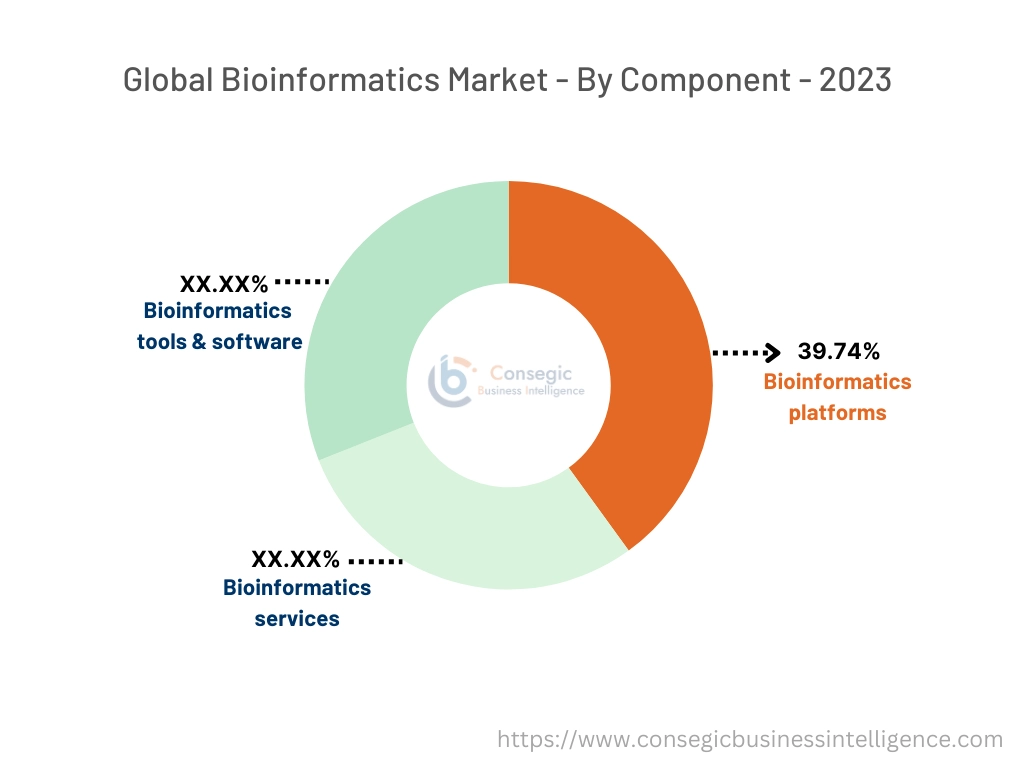
By Application:
Based on application, the market is categorized into genomics, proteomics, metabolomics, pharmacology, and others.
Trends in the Application:
- The increasing adoption of next-generation sequencing technologies is driving the need for advanced genomic analysis tools.
- The growing need for understanding metabolic pathways and biomarkers fuels metabolomics research.
- Adoption of AI and ML to analyze complex biological data, predict protein structures, and identify drug targets.
The genomics segment accounted for the largest market share in the year 2023.
- Genomics is the study of the complete set of genes of organisms, of the way genes work, and interact with each other and with the environment.
- Bioinformatics tools and software such as BLAST (Basic Local Alignment Search Tool), Clustal Omega, and GATK (Genome Analysis Toolkit) are used for sequence alignment and variant calling in next-generation sequencing data.
- Additionally, BWA (Burrows-Wheeler Alignment) is employed for mapping reads to a reference genome, whereas SAMtools is used for manipulating alignment data. Collectively these tools & software are widely utilized to store, retrieve, and analyze vast amounts of genetic data.
- Key applications of these tools & software and platforms in genomics include genome sequencing and assembly, gene prediction and annotation, comparative genomics, population genetics, transcriptomics, epigenetics, and metagenomics.
- Additionally, advancements in tools, software, and platforms for the application of genomics fuel the segment rise in the bioinformatics market size.
- For instance, in November 2022, Arima Genomics partnered with Basepair to accelerate bioinformatics analysis of 3D genomics data. This collaboration simplifies data evaluation by providing a user-friendly interface, reducing computational requirements, and generating easy-to-interpret reports. The partnership aims to streamline the process of identifying structural variants from 3D genomic data, supporting researchers to gain deeper insights into genome structure and function.
- Thus, bioinformatics is significantly boosting genomics research, enabling scientists to understand genetic diseases and evolution.
The drug discovery and development segment is expected to grow at the fastest CAGR over the forecast period.
- Adoption of bioinformatics provides an understanding of the underlying biology of diseases, identifies promising drug targets, designs effective drugs, and optimizes clinical trials in the overall drug discovery and development.
- By leveraging genome-wide association studies, proteomics, and transcriptomics, it enables the identification of genetic variations and molecular targets associated with diseases, facilitating the development of targeted therapies.
- Additionally, structure-based drug design, virtual screening, and pharmacokinetic & pharmacodynamic evaluation enable the identification and optimization of potential drug candidates. By integrating computational tools and biological data, it accelerates drug discovery, enhances drug efficacy, and minimizes side effects.
- Overall, bioinformatics supports drug discovery and development by accelerating the identification and development of effective therapies.
By End-User:
Based on end user, the market is categorized into research institutions, pharmaceutical & biotechnology companies, healthcare organizations, and others.
Trends in the End Use :
- Rising government funding for scientific research and the need for data-driven insights.
- Growing requirement for personalized medicine and the need for efficient drug development.
The pharmaceutical & biotechnology companies segment accounted for the largest market share in the year 2023 and is also expected to grow at the fastest CAGR over the forecast period.
- Bioinformatics has become an indispensable tool for pharmaceutical and biotechnology companies. It is employed at various stages of drug discovery and development, from identifying potential drug targets to optimizing clinical trials.
- By analyzing vast datasets, these tools & software, and platforms help identify specific genes, proteins, or pathways involved in diseases. Additionally, computational methods such as molecular docking, virtual screening, and QSAR modeling (quantitative structure-activity relationship) enable the design and optimization of drug molecules. This supports pharmaceutical and biotechnology companies in identifying drug targets associated with several diseases.
- Moreover, it aids in predicting drug pharmacokinetics and pharmacodynamics, optimizing drug dosing, and minimizing adverse effects further supporting pharmaceutical and biotechnology companies in drug development. In clinical trials, these tools & software, and platforms enable patient stratification, and biomarker discovery, leading to more targeted therapies and improved patient outcomes.
- Rising R&D costs, continuous research requirements, complex computational needs, and complex drug development are driving the adoption of bioinformatics in the pharmaceutical and biotechnology industries.
- For instance, in April 2023, Agilent Technologies Inc. announced the signing of a Memorandum of Understanding (MOU) with Theragen Bio in South Korea to boost precision oncology through advancing bioinformatics solutions. As part of the partnership agreement, Agilent and Theragen Bio will combine their respective strengths in cancer genomic profiling design, engineering knowledge, and software expertise to drive localized evaluation capabilities and accelerate treatment decisions.
- Thus, bioinformatics has become an indispensable tool for pharmaceutical and biotechnology companies, enhancing drug discovery and development.
Regional Analysis:
The regional segment includes North America, Europe, Asia Pacific, the Middle East and Africa, and Latin America.
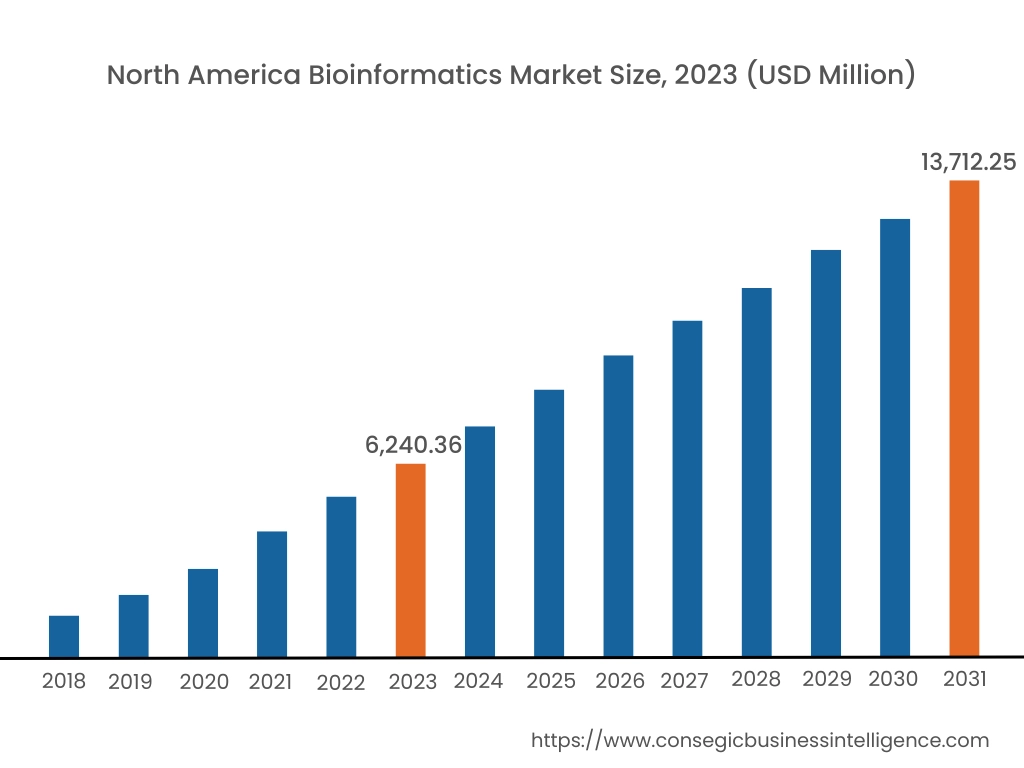
In 2023, North America accounted for the highest market share at 41.23% and was valued at USD 6,240.36 Million and is expected to reach USD 13,712.25 Million in 2031. In North America, the U.S. accounted for the highest market share of 71.23% during the base year of 2023. The bioinformatics market demand is gaining significant rise in North America owing to the confluence of multiple factors such as significant investments in research and development, a strong presence of leading pharmaceutical and biotechnology companies, and a robust academic research ecosystem. The United States leads in this market, with numerous companies specializing in software and services. Government bodies across the region also play a crucial role in driving the bioinformatics market trends through initiatives for genomics research.
- For instance, in May 2022, the federal government launched the Pan-Canadian Genomics Strategy (PCGS), funded through an allocation of USD 400 million announced in Budget 2021. The strategy aims to drive innovation in genomics through commercialization, create socioeconomic growth, and improve Canada's position as a world leader in genomics research and innovation. This creates the requirement for robust tools for genomics research.
Furthermore, the increasing prevalence of chronic diseases and the increasing requirement for personalized medicine are driving the adoption of these solutions in North America. By analyzing large datasets, tools help identify genetic markers for diseases, develop targeted therapies, and improve patient outcomes. The combination of the aforementioned factors and trends is driving a substantial trajectory in the North American bioinformatics market share.
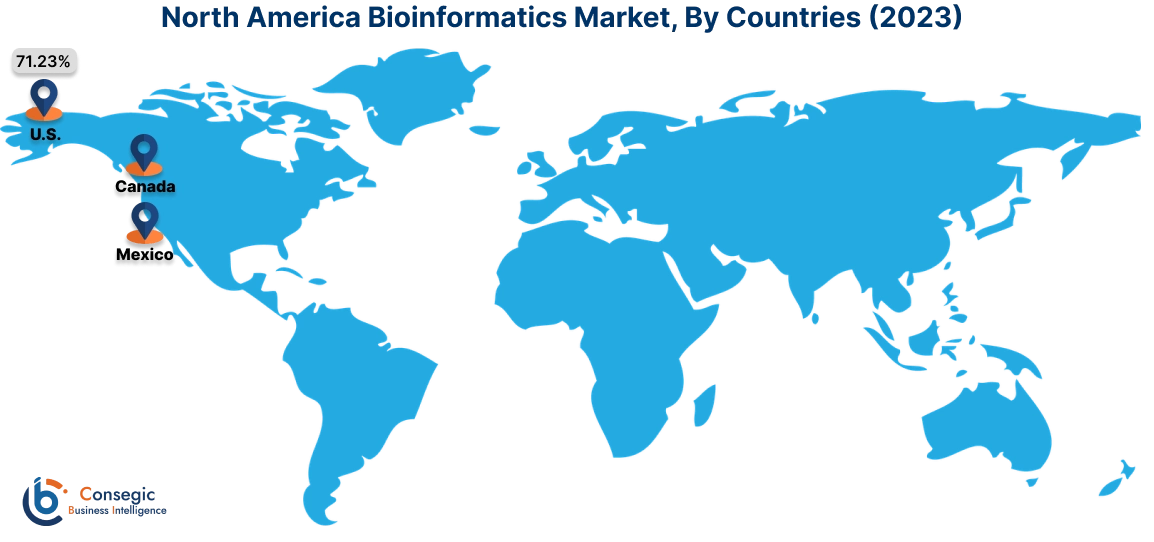
Asia-Pacific is experiencing the fastest growth with a CAGR of 10.9% over the forecast period. The bioinformatics market trend across the region is attributed to factors such as increasing investments in healthcare research and a growing emphasis on personalized medicine. Countries like China, India, Japan, and South Korea are at the forefront of bioinformatics research and development. The region is emerging as a key player in the market, with substantial government funding and the availability of skilled researchers. Additionally, strong IT infrastructure is also contributing to a significant market trajectory, particularly in the areas of genomics and drug discovery. The Asia-Pacific region is also witnessing a growing interest in agricultural biotechnology, with bioinformatics playing a crucial role in improving crop yields, developing disease-resistant crops, and enhancing food security.
Europe presents a significant contribution to the bioinformatics market analysis, boasting a strong scientific and technological infrastructure. The region presents numerous renowned research institutions, universities, and pharmaceutical companies, all of which contribute significantly to the growth of the bioinformatics industry. European countries have been at the forefront of genomics research leading to the development of robust capabilities. The region's emphasis on data privacy and ethical considerations in biomedical research has also shaped the development of tools & software and platforms. Furthermore, the European Union's supportive regulatory environment and funding programs have fostered innovation and commercialization in the bioinformatics sector. The region's strong focus on precision medicine, personalized healthcare, and drug discovery has further fueled the demand for advanced bioinformatics solutions.
The Middle East and Africa (MEA) region is witnessing notable bioinformatics market demand characterized by significant growth potential. Additionally, the burgeoning healthcare sector in the Middle East is playing a pivotal role in demand, leading to increased demand for advanced technologies like bioinformatics. The rising incidence of chronic diseases, such as diabetes, cancer, and heart disease, is driving the need for early diagnosis, personalized medicine, and effective treatment strategies, all of which rely heavily on these tools and platforms. A growing number of academic institutions and research centers in the MEA region are focusing on research. The combined impact of these factors is creating a favorable environment for the trajectory of the bioinformatics market opportunities in the MEA region.
Latin America is an emerging region in the bioinformatics market share, with significant potential for growth and innovation. The region is making steady progress in adopting tools and techniques. Several factors are driving the growth of bioinformatics in Latin America, including increasing investments in research and development, a growing number of academic institutions and research centers, and the emergence of collaborations between researchers from different countries. Countries like Brazil, Mexico, and Argentina are investing in research and development, fostering collaborations between academic institutions, government agencies, and private companies. The region's rich biodiversity and growing healthcare needs offer a promising trajectory for bioinformatics to contribute to advancements in agriculture, medicine, and environmental conservation.
Top Key Players & Market Share Insights:
The Bioinformatics market is highly competitive with major players providing precise measurements between objects to the national and international markets. Key players are adopting several strategies in research and development (R&D) and product innovation to hold a strong position in the global Bioinformatics market. Key players in the Bioinformatics industry include-
- Illumina, Inc. (United States)
- QIAGEN (Netherlands)
- Agilent Technologies, Inc. (United States)
- Waters Corporation (United States)
- Metabolon, Inc. (United States)
- Thermo Fisher Scientific Inc. (United States)
- GenScript (United States)
- Bioinformatics Solutions Inc. (Canada)
- DNAnexus, Inc. (United States)
- BioBam (Spain)
Recent Industry Developments :
New Launch:
- In October 2024, SCIEX, the player in life science analytical technologies, and Bioinformatics Solutions Inc. (BSI), provider of next-generation, deep learning proteomics, and AI-driven biotechnology solutions, advanced their collaboration with the co-development of PEAKS 12.5. This new software launch is fully compatible with the ZenoTOF 7600+ system, offering exclusive commercial support of ZT Scan DIA for proteomics applications.
- In February 2024, Metabolon, Inc., announced the launch of its latest innovation: an integrated bioinformatics platform, advancing the landscape for metabolomics in life sciences research. The platform's unique Biomarker LensesTM feature enables advanced data exploration, allowing researchers to focus on specific pathways and diseases of interest. Statistical techniques such as PCA, PLS-DA, clustering, and volcano plots further facilitate data interpretation and the identification of significant biomarkers.
- In February 2024, QIAGEN announced the launch of QIAGEN Biomedical KB-AI, a new generative AI-driven knowledge base designed to propel drug discovery in the pharma and biotech sector. This new offering is designed for data scientists and bioinformaticians who are looking for the most comprehensive knowledge graphs to fuel data-driven drug discovery.
- In July 2023, FOXO Technologies Inc., a player in the field of commercializing epigenetic biomarker technology, today announced the launch of its cutting-edge Bioinformatics Services to accelerate breakthroughs in biology, biotechnology, and healthcare, and redefine the growing field of epigenetic research.
- In March 2023, Bruker Corporation, in collaboration with Rapid Novor Inc., developed a cutting-edge de novo sequencing algorithm that significantly enhances the accuracy and speed of immunopeptidomics analysis. This novel algorithm, trained on over 1.7 million PASEF data points, enables real-time sequencing of peptides directly from mass spectrometry data. The unmatched sensitivity of the timsTOF SCP system coupled with the new PaSER Novor algorithm delivers a significant performance boost for immunopeptidomics, especially for small tumor biopsy samples.
- In January 2023, QIAGEN Digital Insights, the bioinformatics business of QIAGEN, announced their enhanced QIAGEN CLC Genomics Workbench Premium. This enhanced platform is designed to streamline the evaluation and interpretation of extensive genomic data, such as whole genome sequencing (WGS), whole exome sequencing (WES), and large panel sequencing data.
- In March 2022, ARUP Laboratories announced the launch of Rio, a new world-class bioinformatics pipeline and analytics platform. Rio amplifies ARUP's existing cloud computing capabilities to move data more efficiently and with greater accuracy to speed targeted test results to clinicians for analysis and improved medical decision-making for patients.
Partnership:
- In November 2022, Arima Genomics partnered with Basepair to make its 3D genomic bioinformatics pipelines more accessible to scientists. This collaboration simplifies data analysis by providing a user-friendly interface, reducing computational requirements, and generating easy-to-interpret reports. The partnership aims to streamline the process of identifying structural variants from 3D genomic data, empowering researchers to gain deeper insights into genome structure and function.
Bioinformatics Market Report Insights :
| Report Attributes | Report Details |
| Study Timeline | 2018-2031 |
| Market Size in 2031 | USD 32,663.77 Million |
| CAGR (2024-2031) | 10.2% |
| By Component |
|
| By Application |
|
| By End-User |
|
| By Region |
|
| Key Players |
|
| North America | U.S. Canada Mexico |
| Europe | U.K. Germany France Spain Italy Russia Benelux Rest of Europe |
| APAC | China South Korea Japan India Australia ASEAN Rest of Asia-Pacific |
| Middle East and Africa | GCC Turkey South Africa Rest of MEA |
| LATAM | Brazil Argentina Chile Rest of LATAM |
| Report Coverage |
|
Key Questions Answered in the Report
How big is the Bioinformatics market? +
In 2023, the Bioinformatics market is USD 15,135.48 Million.
Which is the fastest-growing region in the Bioinformatics market? +
Asia Pacific is the fastest-growing region in the Bioinformatics market.
What specific segmentation details are covered in the Bioinformatics market? +
Component, Application, and End User segmentation details are covered in the Bioinformatics market.
Who are the major players in the Bioinformatics market? +
Illumina, Inc. (United States), QIAGEN (Netherlands), Thermo Fisher Scientific Inc. (United States), and GenScript (United States) are some of the major players in the market.
